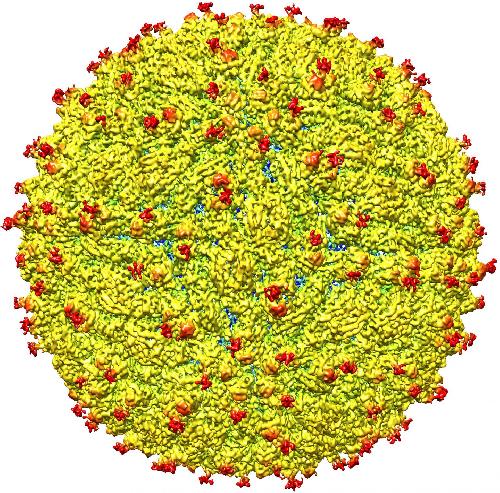A new study reveals the structure of the Zika virus, shedding light on its similarities and differences compared to viruses of the same family. The ongoing Zika virus epidemic is of grave concern because of apparent links to congenital microcephaly, a medical condition in which the brain does not develop properly, resulting in a smaller than normal head, as well as Guillain Barre syndrome. To learn more about the structure of Zika and possible ways to therapeutically target the virus, Devika Sirohi and colleagues used cryo-electron microscopy to analyze a strain isolated from an infected patient during the French Polynesia epidemic in 2013-14. Their analysis reveals that Zika's structure is very similar to that of other flaviviruses, and particularly similar to dengue. However, Zika appears to have a slightly different structure in a region that in dengue facilitates binding to antibodies and to host receptors. This region may be important in Zika virus attachment, entry and disease progression.
 A representation of the surface of the Zika virus is shown. A team led by Purdue University researchers is the first to determine the structure of the Zika virus, which reveals insights critical to the development of effective antiviral treatments and vaccines. This material relates to a paper that appeared in the April 1, 2016, online issue of Science, published by AAAS. The paper, by D. Sirohi at Purdue University in West Lafayette, Ind., and colleagues was titled, "The 3.8Å resolution cryo-EM structure of Zika Virus." Credit: Purdue University image/courtesy of Kuhn and Rossmann research groups
A representation of the surface of the Zika virus is shown. A team led by Purdue University researchers is the first to determine the structure of the Zika virus, which reveals insights critical to the development of effective antiviral treatments and vaccines. This material relates to a paper that appeared in the April 1, 2016, online issue of Science, published by AAAS. The paper, by D. Sirohi at Purdue University in West Lafayette, Ind., and colleagues was titled, "The 3.8Å resolution cryo-EM structure of Zika Virus." Credit: Purdue University image/courtesy of Kuhn and Rossmann research groups
source: American Association for the Advancement of Science